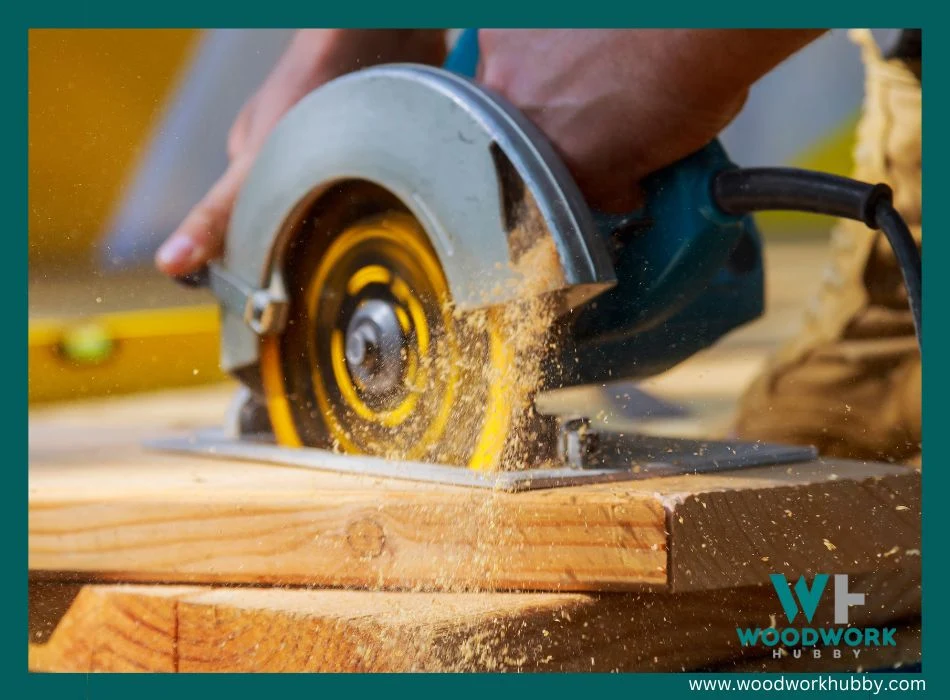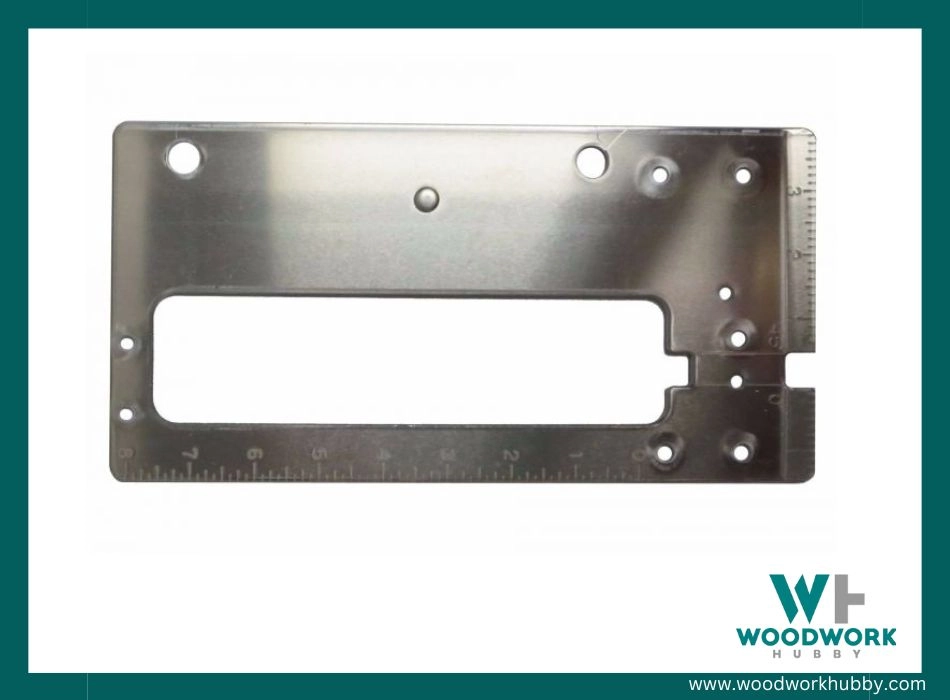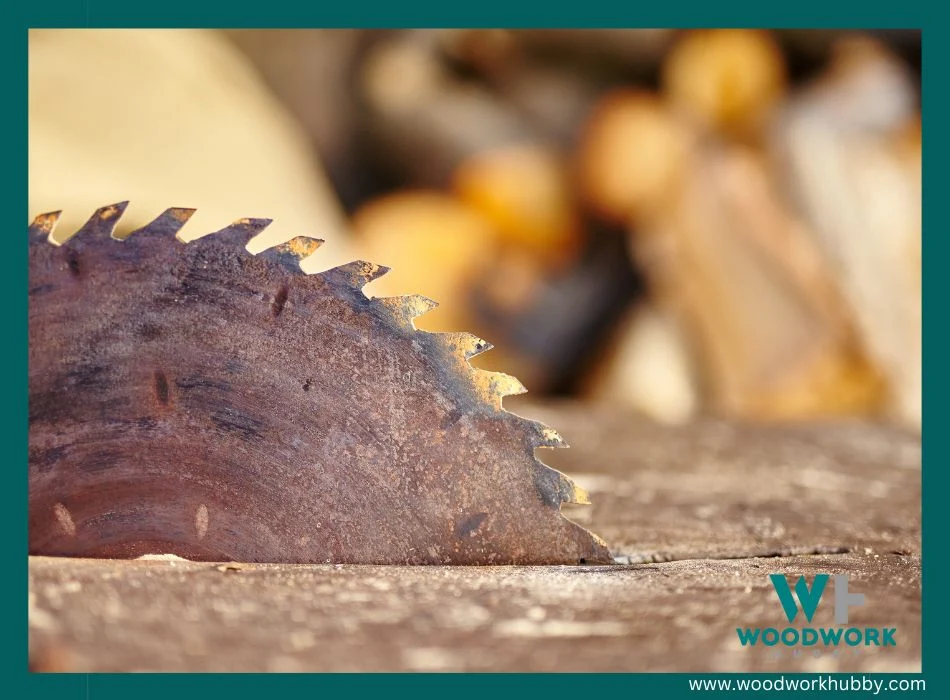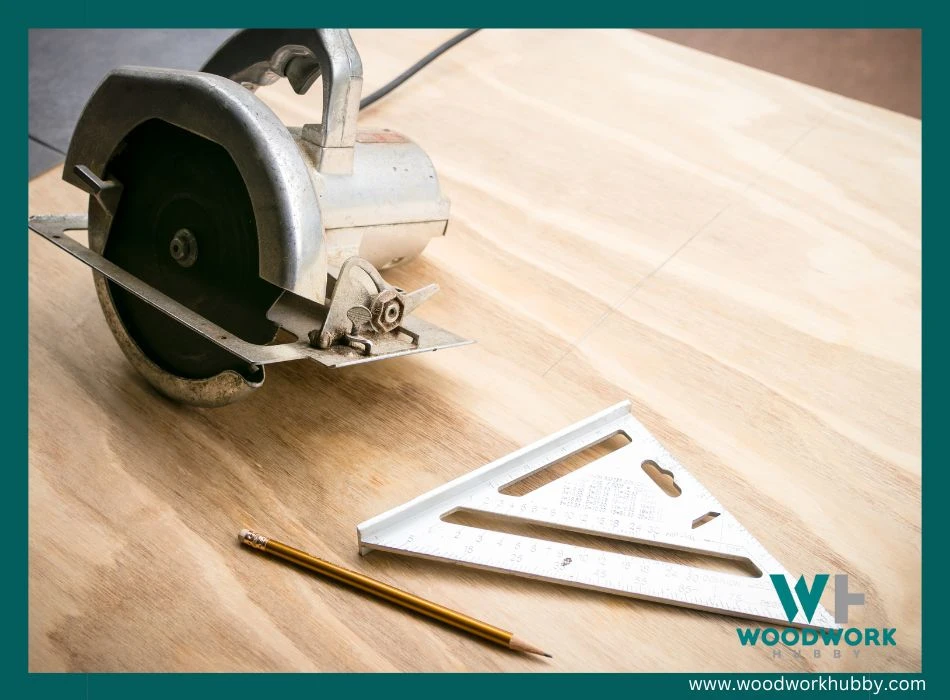Have you ever wondered, “Why is my circular saw not cutting straight?” You’re not alone; as an experienced woodworker, I’ve been there and understand how frustrating it can be. But don’t worry! After extensive research and trial and error, I’ve discovered seven quick fixes to ensure your circular saw cuts straight every time.
Key Takeaways
- Proper blade alignment is crucial for achieving straight cuts with a circular saw. Ensuring that the blade is securely fastened to the arbor and checking alignment before each use will prevent wobbling and inaccurate cuts.
- A worn-out or warped blade can cause a circular saw to not cut straight. Regularly inspecting blades for signs of wear and replacing them as needed with high-quality, durable options will improve cutting accuracy.
- Holding the base plate flat on the timber and avoiding fast feeding during cutting are key factors in achieving straight cuts. Maintaining proper contact between the baseplate and wood surface, as well as maintaining a steady pace, will result in cleaner and more precise cuts.
Understanding a Circular Saw
A circular saw is a versatile tool used in woodworking, known for its ability to make straight cuts through various materials. It consists of several essential parts, each with its own function.

The blade depth and angle are crucial factors that determine the accuracy of the cut, while the baseplate provides stability and support during cutting operations.
Brief Overview of the Parts and Functions
In the realm of woodworking, a circular saw stands as a versatile tool. Understanding its parts and functions is pivotal to mastering straight cuts. Here’s the lowdown on crucial components: The heart of this power tool is the motor that drives the rotation of your chosen saw blade.
This blade, whether high-quality or low-quality, impacts cutting quality significantly and requires regular maintenance for optimal performance. Holding everything together is the saw shoe or base plate; it ensures stable contact with your workpiece and guides your cut in conjunction with blade depth adjustments.
I wrote this article on how often you should sharpen circular saw blades.
Lastly, we have features like guards for safety purposes, handles for user control, bevel adjustment knobs to aid angular cuts – all playing intricate roles in ensuring smooth operation while using a circular saw.
Importance of Blade Depth and Angle of the Cut
Mastering the depth and angle of your circular saw blade is essential for achieving flawless, straight cuts. Setting the right blade depth ensures you’re not cutting more material than necessary, reducing the risk of binding and improving overall control during cuttings.
As for the angle, a 90-degree position usually provides the cleanest and most precise cuts. However, adjusting it according to woodworking needs can yield a variety of cutting styles – be it miter cuts or crosscuts – ensuring functionality across different projects while maintaining accuracy in each cut.
Poorly aligned blades often result in wider kerf paths leading to less-than-perfect results; therefore regular checks and adjustments are key ingredients to your success with this versatile tool.
Check out my full write-up on can circular saws cut angles.
Regular maintenance also extends your saw blade’s life making sure every task is executed smoothly without major hiccups such as crooked cuts or smoking from the workpiece due to fast feeding.
Role of the Baseplate in Cutting Accuracy
The baseplate of your circular saw acts like a road map for the blade, guiding it as it makes its way through your workpiece. With a steady and even plate, you reduce the chance of wobbling, which can throw off your cuts.

A flat baseplate that’s parallel to the saw blade ensures accurate and straight cutting paths. If there’s any damage or warp, such as bends or dents on this crucial part of your tool – don’t ignore it! Even slight deformations can cause significant inaccuracies in your cuts.
It’s vital to ensure that the baseplate is flush with the workpiece when making a cut – if not, then adjustments should be made promptly. Regular inspection and maintenance help keep this guide track in prime condition so that each cut remains true to its intended path.
Common Reasons for a Circular Saw Not Cutting Straight
- The circular saw blade may be misaligned or loose, causing the blade to wobble and result in a crooked cut.
- A worn-out or warped saw blade can also cause the circular saw to not cut straight.
- If the base plate is not set at a 90-degree angle, it can lead to angled cuts instead of straight ones.
- Not holding the base flat on the timber while cutting can result in uneven and jagged cuts.
- Fast feeding during cutting can cause the saw to veer off course and create a crooked cutting path.
- Incorrectly installed blades can throw off the balance of the saw, leading to inaccurate cuts.
- Lastly, if your circular saw is stressed or old, it may have difficulty maintaining a straight cutting line.
1. Misaligned or Loose Blade
One common reason why your circular saw might not be cutting straight is due to a misaligned or loose blade. When the blade is not properly aligned with the base plate, it can cause the saw to veer off course and create crooked cuts.
Video showing common circular saw mistakes
Additionally, if the blade is loose and wobbly, it will lack stability and precision during cutting. To address this issue, it’s important to check for any misalignment or looseness in the blade.
By tightening the arbor nut securely and ensuring that all bolts are properly fastened, you can improve the alignment and stability of the blade for cleaner and straighter cuts. Regular inspection and maintenance of your saw’s components will help prevent these issues from occurring in the future.
2. Worn-Out or Warped Blade
One of the most common reasons for a circular saw not cutting straight is a worn-out or warped blade. Over time and with regular use, saw blades can become dull, bent, or warped, leading to uneven cuts.

A dull blade will struggle to cut through materials effectively and may cause unnecessary friction or binding. On the other hand, a warped blade can create an irregular cutting path and result in crooked lines.
To address this issue, it’s crucial to regularly inspect your saw blades for signs of wear or damage. If you notice any chips on the teeth or if the blade has become significantly dull, it’s likely time for a replacement.
If your blade is really blunt it may start smoking. This happened to me and you can read about it here.
3. Base plate is not set at 90 degrees
One of the common reasons for a circular saw not cutting straight is when the base plate is not set at 90 degrees. When the base plate is misaligned, it can cause the saw to veer off and result in crooked cuts.
Use a square to hold against the base and the blade to ensure it is square. Just make sure the square sits between the teeth.
4. Not holding the base flat on the Timber
One common reason why a circular saw may not be cutting straight is if you’re not holding the base flat on the timber. When using a circular saw, it’s crucial to ensure that the baseplate is firmly and evenly in contact with the surface of the wood.
If there are gaps or uneven pressure, it can cause the blade to veer off course, resulting in crooked cuts. By maintaining proper contact between the baseplate and timber, you’ll have better control over your cuts and achieve straighter lines.
5. Fast Feeding
One common reason why a circular saw may not be cutting straight is due to fast feeding. When you feed the workpiece too quickly through the saw, it can cause the blade to bind or wander off course, resulting in crooked cuts.
Be PATIENT and let the saw cut the wood. Don’t force it!
It’s important to maintain a steady and controlled pace when guiding the workpiece through the saw, allowing the blade to cut smoothly and accurately. By taking your time and avoiding rushing, you’ll ensure that your circular saw cuts straight and produces clean results every time.
6. Incorrectly Installed Blade
One common reason for a circular saw not cutting straight is having the blade installed incorrectly. If the blade is not properly aligned with the arbor, it can cause the saw to veer off course during cuts.
This misalignment can result in crooked or uneven cuts, making it difficult to achieve clean and precise lines. To fix this issue, ensure that you are aligning the outer flange and nut correctly when installing or replacing the blade.
By taking the time to install the blade properly, you’ll improve your chances of achieving straight and accurate cuts with your circular saw.
7. Saw is Stressed or Old
I’ve come across many cases where a circular saw isn’t cutting straight because the saw itself is stressed or old. Over time, regular use and wear can cause the components of the saw to become misaligned or weakened, resulting in crooked cuts.
Additionally, if the saw hasn’t been properly maintained or serviced, it may not perform at its best and struggle to cut straight. It’s important to regularly check for any signs of stress or wear on your circular saw and address them promptly to ensure accurate and precise cuts.
Quick Fixes for a Circular Saw not Cutting Straight
Here are some quick fixes to help you achieve straight cuts with your circular saw: replace a warped blade, ensure proper blade alignment, clamp the workpiece securely, and use a speed square or guide rail for precise cutting.
Replacing a Warped Blade
If you notice that your circular saw is not cutting straight, one possible culprit could be a warped blade. A warped blade can result in uneven cuts and make it difficult to achieve clean lines.
This issue is commonly caused by using low-quality blades or subjecting the blade to excessive heat or stress. It’s important to replace a warped blade promptly to ensure accurate and precise cuts.
High-quality saw blades are made with long-life materials and designed to withstand multiple resharpenings, providing consistent performance over time. By replacing a warped blade with a reliable one, you can improve the cutting accuracy of your circular saw and achieve better woodworking results.
Proper Blade Alignment
One crucial aspect of ensuring a circular saw cuts straight is proper blade alignment. When the blade on your circular saw is not aligned correctly, it can lead to crooked cuts and an uneven cutting path.
This misalignment often happens when the circular saw’s blade is not properly installed with the arbor flange and nut. An improperly tightened or loose blade can wobble during cutting, resulting in wider kerf paths and inaccurate cuts.
To achieve proper blade alignment, it’s important to securely fasten the saw blade onto the arbor using the outer flange and nut. Tightening them down evenly will ensure that there is no movement or wobbling once you start cutting.
Regularly checking and adjusting your blade’s alignment before each use will help maintain accurate cuts consistently.
Clamping the Workpiece
For straight and precise cuts with a circular saw, it is crucial to securely clamp the workpiece in place. This ensures that the wood stays stable and doesn’t move or shift during the cutting process.
Sliding workpieces can cause kickback, binding, and even burning marks on your material. By clamping down your workpiece onto a table or platform, you guarantee its stability throughout the entire cut.
This not only improves safety but also helps maintain accuracy for clean and professional-looking results. So before firing up your circular saw, make sure to secure your workpiece firmly so you can confidently achieve those straight cuts without any unwanted surprises along the way!
Square up base plate
To ensure that your circular saw cuts straight, it’s essential to square up the base plate. The base plate serves as a guide for the blade and plays a crucial role in maintaining accuracy.
When the base plate is not set at a 90-degree angle to the blade, it can cause your cuts to veer off course and lead to uneven edges. By taking the time to adjust and align the base plate correctly, you’ll be able to achieve clean and precise cuts every time.
Remember that regular maintenance, including checking and adjusting the alignment of your circular saw’s components, is key in ensuring its accuracy and performance.
Using a Speed Square or Guide Rail
One effective way to ensure straight cuts with a circular saw is by using a speed square or guide rail. A speed square, made of metal, serves as a short guide fence for cuts under 8 inches.
It has measurement markings and an L-shaped design that allows you to align the saw blade accurately along the edge of the workpiece. By firmly holding the speed square against the material and running your circular saw along its edge, you can achieve precise and straight cuts every time.
Similarly, a guide rail is a longer and more versatile alternative that provides continuous support for longer cuts. It acts as a straight reference line for your saw to glide smoothly along, eliminating any chances of deviation from your intended cutting path.
Checking the Material You’re Cutting
When using a circular saw, it’s important to check the material you’re cutting to ensure that it’s suitable for your saw blade and cutting technique. Different materials require different types of blades and cutting speeds, so it’s essential to know what you’re working with.

For example, if you’re cutting hardwood or dense materials, a high-quality blade with carbide tips will be more effective and durable than a low-quality blade. On the other hand, softer materials like plywood may require a blade with more teeth for cleaner cuts.
Checking the material also involves inspecting its condition. Warped or uneven surfaces can cause the saw blade to bind or deflect during cutting, resulting in crooked cuts. It’s important to flatten or stabilize these surfaces before making your cut.
Practice and Experience
As a circular saw user, I’ve come to understand that achieving straight cuts requires practice and experience. It’s important to remember that using a circular saw is a skill that takes time to develop.
The more you use it, the better you become at controlling the saw and maintaining a steady cutting path. Through practice, you’ll gain an understanding of how different materials respond to the blade and learn to adjust your technique accordingly.
Experience also teaches you how to properly hold the saw, apply consistent pressure, and guide the workpiece along the desired cutting line.
Frequently Asked Questions
Let’s delve into some common queries that people often have when dealing with circular saws not cutting straight:
1. What role does a saw blade play in a circular saw not cutting straight? Answer: A poor quality or warped saw blade is one of the leading causes of a circular saw not cutting accurately.
2. How can I prevent my workpiece from slipping while I’m cutting? Answer: Securing the workpiece with clamps or placing it on a stable table or platform can prevent slipping and contribute to a straighter cut.
3. Why does my saw produce smoking and burning marks on the workpiece? Answer: Fast feeding during cutting can lead to crooked paths and cause the workpiece to smoke or burn.
4. What should I do if my saw blade is warped? Answer: If your saw blade is warped, consider replacing it with a flat blade. Remember, high-quality saw blades are designed to be resharpened multiple times.
5. Can a guide rail or speed square help in achieving straight cuts with a circular saw? Answer: Yes, using a saw track or a speed square can greatly improve the accuracy of your cuts.
6. What safety measures should I adhere to when using a circular saw? Answer: Always follow safety guidelines, including using protective equipment, to prevent accidents while operating a circular saw.
7. Can the type of material I’m cutting affect the straightness of the cut? Answer: Yes, it’s essential to check the material you’re cutting with your circular saw. Some materials might require specific blades or techniques for accurate cuts.
Conclusion – Why Is My Circular Saw Not Cutting Straight?
In conclusion, if you’re experiencing issues with your circular saw not cutting straight, there are several quick fixes that can help improve accuracy. By replacing a warped blade, properly aligning the blade, clamping the workpiece securely, and using tools like a speed square or guide rail, you can achieve straight cuts with ease.
Remember to practice and gain experience to master the art of using a circular saw effectively. With these quick fixes and some patience, you’ll be creating precise woodworking projects in no time.
FAQs
1. Why is my circular saw not cutting straight?
There could be several reasons why your circular saw is not cutting straight. Some common causes include a dull or improperly aligned blade, incorrect blade depth, worn-out or damaged guide rail, or an issue with the saw’s motor or base.
2. How can I fix a circular saw that is not cutting straight?
To fix a circular saw that is not cutting straight, you can try various quick fixes such as checking and aligning the blade, adjusting the blade depth, replacing worn-out guide rails, cleaning and lubricating the saw’s components, ensuring proper power supply to the motor, and maintaining a steady hand while making cuts.
3. Can using a low-quality or wrong type of blade cause my circular saw to cut inaccurately?
Yes, using a low-quality or wrong type of blade can affect the accuracy of your cuts with a circular saw. It is essential to use high-quality blades specifically designed for your intended material and ensure they are sharp and in good condition.
4. When should I consider seeking professional help for fixing my circular saw’s cutting accuracy?
If you have tried all the recommended quick fixes and your circular saw still does not cut straight or if you are unsure about performing any repairs yourself, it may be best to seek professional help from a qualified technician who specializes in power tool repair. They will have the expertise to diagnose and resolve any underlying issues affecting your tool’s performance accurately.




